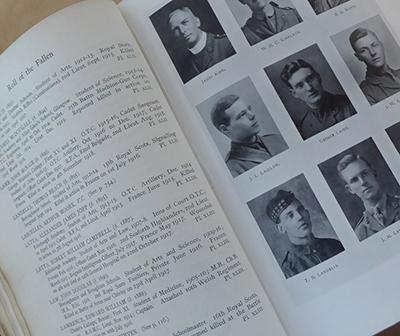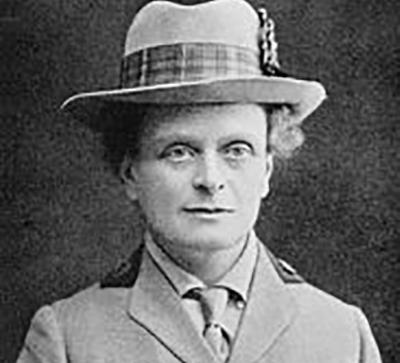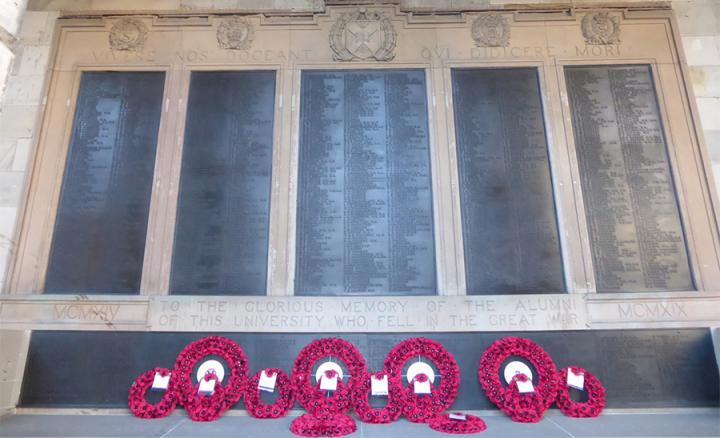"From these gates of learning": Remembering those who served and fell in the Great War
On the centenary of the publication of the University of Edinburgh Roll of Honour, Professor Jeremy Crang (Professor of Modern British History) takes a closer look at this remarkable document and the University's main war memorial.

The impact of the Great War was felt deeply in university communities across Britain. ‘A shadow was thrown over the whole earth,’ remarked one student periodical in 1919, ‘and nowhere did it fall more darkly than on the universities.’ In the immediate aftermath of the conflict, Edinburgh University, like other institutions, sought to commemorate and memorialise those of its members - staff, students and alumni - who had served and fallen in the war. They were to be honoured through the compilation of a roll of honour and the creation of a memorial at the very heart of the university in Old College Quad.
A prodigious feat of research
Preparations for the university’s roll of honour began early in the war. In the autumn of 1914, the university court appointed a roll of honour committee to gather the details of serving members of the university through advertisements in newspapers and other sources. Then, at the end of the conflict, all students who had matriculated since 1900 were circularised and 20,000 war service questionnaires sent out for completion - which must have been a huge undertaking at the time. In 1919, Major John Mackenzie, adjutant of the university’s Officers’ Training Corps, was appointed to edit the roll and in 1921 it was published by Oliver and Boyd in Edinburgh.
As well as being a prodigious feat of research, this 786-page volume is an extraordinary record of the war service of members of our university. According to the roll, some 8,000 served with the British, Dominion or Allied armed forces and approximately 950 died in the conflict. The volume incorporates biographical details of all those who served and, remarkably, includes personal photographs of 850 of the fallen which lends a special poignancy to the list of the dead since we are invited to imagine the individual stories told in each of the faces.

Among the images are two female faces. One is Dr Elsie Inglis, a medical graduate who founded the female-staffed Scottish Women’s Hospitals to treat casualties at the front and served in Serbia and Russia; and the other is Dr Marian Wilson, another graduate of medicine, who served with the Scottish Women’s Hospitals in France.
Breaking down the figures, it is interesting to note that the largest proportion of university members (about half of the total) served in the medical branches of the armed forces, which is a reflection of the prominence of the university’s medical school at this time. However, the highest casualty rates were - unsurprisingly - among those who served with the infantry. It is sobering to record that over a quarter of those in the infantry regiments perished.
Decorations for gallantry are also included in the roll and it’s notable that over 700 Military Cross medals were awarded to members of the university and five received the Victoria Cross. Two of these VC winners were former members of the University OTC which continued to be an active training centre for cadets throughout the war.
The roll of honour was widely distributed after its publication. A copy was sent to the families of the fallen, as well as to the king, the prime minister and nearly 100 libraries and public institutions, including the Library of Congress in Washington. Importantly, it was also used as the basis for the names inscribed on the university’s war memorial in Old College Quad.
Vivere nos doceant qvi didicere mori
This memorial was designed by Sir Robert Lorimer, who created the Scottish National War Memorial at Edinburgh Castle, and it incorporates the names of the fallen on five bronze tablets. Above the names is a bronze figure set into the wall by Charles Pilkington Jackson which represents ‘good overcoming evil’, and a Latin inscription composed by Professor Oliffe Richmond, the Chair of Humanity, which translates as ‘May those who learned how to die teach us how to live’. Below the names is an extract from a speech given by Rudyard Kipling when he received an honorary degree from the university in 1920 and it reads as follows: "They turned without fear or question from these gates of learning to those of the grave in order that free men might still continue to learn freedom."
The memorial was unveiled by Lord Balfour, the Chancellor of the university, on 19 February 1923 and it was by all accounts a most impressive occasion. The ceremony was attended by a great gathering of staff, students and relatives of the fallen, and those who could not squeeze into the Quad watched from the windows and balconies or clambered up onto the high pediments of Old College. A service of dedication was opened with a prayer from the Dean of the Faculty of Divinity; Lord Balfour ascended the steps to remove the large Union Jack which had been draped around the memorial; laurel wreaths were laid by the Principal and the President of the Students’ Representative Council; and buglers hidden out of sight in the stone galleries played the ‘Last Post’ which was said to have echoed hauntingly around and above Old College.

One commentator wrote that never in its history had the Quad witnessed such a scene and that ‘if, as it is anciently believed, the spirits of the departed love to haunt the scenes with which they were closely associated during their lives, the Old Quadrangle has its genii loci.’
In his speech at the ceremony, Balfour spoke of the dreadful human suffering caused by the war and of the sense of a lost generation. ‘We have lost men’, he said, ‘who would have been great statesmen, great poets, great writers, great thinkers, leaders in science, leaders in religion, leaders in all social effort.’ But drawing on the sentiments of the Latin inscription on the memorial, he also reminded those present of the enormous debt they owed to the fallen and to the example of sacrifice they had set. ‘We should think of them,’ he urged, ‘with pride, gratitude, and thankfulness’.
It is also worth remembering that for the Dean of the Faculty of Divinity, who officiated at the service of dedication that winter’s afternoon, it was a deeply personal occasion. The Very Rev Professor William P. Paterson had lost two of his sons in the war, one of whom - twenty-one-year-old Robert - had been a student of Arts at the university and was listed on the bronze plaques unveiled by Balfour that day.
Paterson was profoundly affected by his loss and it was said that when he and his wife visited the battlefields where their sons had fallen they were to be seen crawling over the sacred ground on their knees in the hope of finding something to connect them to their boys’ final hours.
Remembrance service
The University will be holding a Remembrance service on Sunday 14 November along with Heriot-Watt University, Edinburgh Napier University and Queen Margaret University. Due to ongoing Covid restrictions you should register to attend here.
Further information
This article is an extract from Jeremy Crang's introduction to a public lecture given by Professor Ewen Cameron on 'Scotland and the Great War' in the Playfair Library, Old College, November 2018, to mark the centenary of the end of the conflict.
The University of Edinburgh Roll of Honour (online - searchable)

